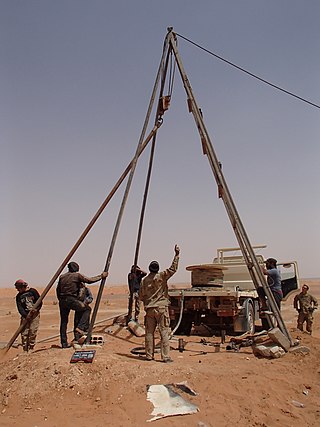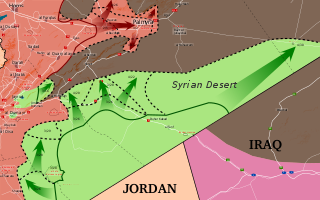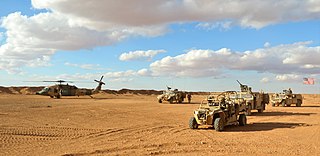Al-Waleed border crossing is one of three official border crossings between Iraq and Syria. It is located in the Ar-Rutba District of the Al-Anbar Governorate in western Iraq, close to the northeasternmost point of Jordan in the Syrian Desert. It serves as the main border checkpoint on the highway between Damascus and Baghdad. The al-Waleed checkpoint is close to al-Tanf on the Syrian side of the border in the Homs Governorate. The Al-Waleed Palestinian refugee camp is nearby.

The Southern Front was a Syrian rebel alliance consisting of 54 or 58 Syrian opposition factions affiliated with the Free Syrian Army, established on 13 February 2014 in southern Syria. By June 2015, the Southern Front controlled about 70 percent of Daraa Governorate, according to the International Institute for Strategic Studies; by 2018, the front was defunct, with most of its fighters either reintegrating into the Syrian Army or fleeing to other FSA held lands in the north.

The Forces of Martyr Ahmad al-Abdo is a Syrian rebel group previously affiliated with the Free Syrian Army's Southern Front. The group was named after either Ahmad al-Abdo al-Saeed, a Syrian civilian who was killed in the early 2011 protests, or first lieutenant Ahmad al-Abdo, a rebel commander who was killed in action during the war. The group received support from the Friends of Syria Group.

Jaysh al-Jihad was an Islamist rebel group based in Quneitra Governorate. The group formed from the merger of seven small independent groups and factions that defected from Nusra Front after it clashed with the Yarmouk Martyrs Brigade in December 2014. These groups were: Jihad Brigades, Jamaat Jund al-Islam, Jamaat Abu Baseer, Mujahideen of al-Sham movement, Jamaat Shabab Ahl al-Sunnah, Nurayn Brigade, and Jamaat Bunyan al-Marsous.

The Palmyra offensive of May 2015 was a military operation launched during the Syrian Civil War by the Islamic State of Iraq and the Levant (ISIL) on May 13–26, 2015, in an attempt to capture the government-held Tadmur District of the Homs Governorate, including the administrative centre of Tadmur, known in English as Palmyra. The ruins and ancient monuments of Palmyra, which lie on the south-western fringe of the modern city, have been a UNESCO World Heritage Site since 1980. The ruins were part of a desert oasis that was one of the most significant cultural centers of the ancient world, linking the civilizations of Persia, India, China with the Roman Empire through trade. The offensive was one of the largest offensives launched by ISIL, the largest one conducted by ISIL in Syria since the 2014 Eastern Syria offensive, with the result of the offensive increasing ISIL's control of Syria to at least 50%.

The Syrian Train and Equip Program is a United States-led military operation launched in 2014 that identified and trained the Kurdish YPG, Revolutionary Commando Army, and select other opposition groups inside Syria as well as in Turkey and other US-allied states who would then return to Syria to fight the Islamic State of Iraq and the Levant. The program reportedly cost the US $500 million. It was a covert program, run by U.S. special operations forces, separate from Timber Sycamore, the parallel covert program run by the Central Intelligence Agency (CIA). As of July 2015, only a group of 54 trained and equipped fighters had been reported to have been deployed, which was quickly routed by al-Nusra, and a further 75 were reported in September 2015.

The 2016 Abu Kamal offensive, also known as Operation Day of Wrath, was launched on the town of Abu Kamal on the Syrian–Iraqi border led by the US-backed New Syrian Army (NSA).

The Palmyra offensive in December 2016 was a military operation launched by the military of ISIL which led to the re-capture of the ancient city of Palmyra, and an unsuccessful ISIL attack on the Tiyas T-4 Airbase to the west of the city. ISIL previously controlled the city from May 2015 until March 2016.

The Military Security Shield Forces, also called the Military Intelligence Shield Force or simply Military Shield, was a pro-government militia involved in the Syrian Civil War that was affiliated with the Military Intelligence Directorate.

The Syrian Desert campaign was a military campaign launched by Syrian rebel forces affiliated with the Free Syrian Army's Southern Front and their allies in the southern Syrian Desert and the eastern Qalamoun Mountains. The aim of the offensive was to expel the Islamic State of Iraq and the Levant from the desert in southern Syria and to open a supply route between two rebel-held areas.

The Palmyra offensive in 2017 was launched by the Syrian Arab Army against the armed forces of the Islamic State of Iraq and the Levant (ISIL) in the Eastern Homs Governorate in January 2017, with the goal of recapturing Palmyra and its surrounding countryside. ISIL forces had retaken the city of Palmyra in a sudden offensive from 8 to 11 December, after previously being expelled from it by Syrian government and Russian forces in March 2016. On 2 March 2017, the Syrian Army alongside Russian reinforcement, succeeded again in recapturing the beleaguered city of Palmyra.

The Eastern Homs offensive in 2017 was a military operation of the Syrian Arab Army and its allies in Eastern part of Homs Governorate against Islamic State of Iraq and the Levant forces during the Syrian Civil War.

The Syrian Desert campaign was a large-scale military operation of the Syrian Army that initially started along the highway from Damascus to the border with Iraq against rebel forces during the Syrian civil war. Its first intended goal was to capture both the highway and the al-Tanf border crossing, thus securing the Damascus countryside from a potential rebel attack. Later, multiple other fronts were opened as part of the operation throughout the desert, as well as operation "Grand Dawn" against ISIL with the aim of reopening the Damascus-Palmyra highway and preparing for an offensive towards Deir ez-Zor.
The Al-Tanf offensive was a two-day offensive launched by the Free Syrian Army backed by the U.S.-led Coalition against the Islamic State of Iraq and the Levant (ISIL), aiming to recapture al-Tanf, Syria. Al-Tanf had been captured by ISIL from the Syrian Government in May 2015 and had been used by ISIL to shift militants and resources across the border.

Al-Tanf is a U.S. military base in a part of the Rif Dimashq Governorate, Syria, which is controlled by the Free Syrian Army. It is located 24 km west of the al-Walid border crossing in the Syrian Desert. The surrounding deconfliction zone is located along the Iraq–Syria border and the Jordan–Syria border. The garrison is located along a critical road known as the M2 Baghdad–Damascus Highway. The Rukban refugee camp for internally displaced Syrians is located within the deconfliction zone.
Opposition–ISIL conflict during the Syrian Civil War started after fighting erupted between Syrian opposition groups and the Islamic State of Iraq and the Levant (ISIL). In early January 2014, serious clashes between the groups erupted in the north of the country. Opposition groups near Aleppo attacked ISIL in two areas, Atarib and Anadan, which were both strongholds of the fundamentalist Sunni organization. Despite the conflict between ISIL and other rebels, one faction of ISIL has cooperated with the al-Nusra Front and the Green Battalion to combat Hezbollah in the Battle of Qalamoun. By 2018.

The U.S. intervention in the Syrian civil war is the United States-led support of Syrian opposition and Rojava during the course of the Syrian civil war and active military involvement led by the United States and its allies — the militaries of the United Kingdom, France, Jordan, Turkey, Canada, Australia and more — against the Islamic State of Iraq and the Levant (ISIL) and al-Nusra Front since 2014. Since early 2017, the U.S. and other Coalition partners have also targeted the Syrian government and its allies via airstrikes and aircraft shoot-downs.














